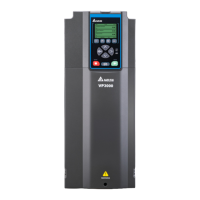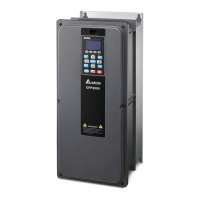Chapter 5 Initial Operation and Adjustment | VP3000
226
5-4-2-3 Adjustment Steps
※ You need to complete A-0 IM Autotune first (refer to Section 5-3-2).
1. Choose the motor control method.
Set Pr. C0-02 = 1: SVC.
2. Setup stop method.
4. Execute no-load operation.
If the motor operating direction is different from the definition, adjust Pr. A1-28 Forward Phase
Selection = 1: UWV.
5. Check if the motor can operate to the operation frequency without abnormal sound.
(1) If the motor resonates, increase setting for Pr. E0-33 IM1 SVC Hunt Compensation Gain.
(2) If there is motor excitation noise, increase setting for Pr. A5-00 Carrier Frequency
Setting.
6. Execute load operation.
(1) If the motor vibrates in low-frequency or has insufficient loading capacity, increase setting
for Pr. E0-30 IM1 SVC Torque Compensation P Gain to enhance the loading capacity for
full frequency range; however, it may cause over current if you set this parameter too
large.
(2) If the output current is too large, decrease setting for Pr. E0-30 IM1 SVC Torque
Compensation P Gain or increase setting for Pr. E0-32 IM1 SVC Torque Compensation
Filter.
7. If the start loading capacity is insufficient, set the required low-frequency flux boost frequency
range through Pr. E0-25 IM1 SVC Flux Boost Decay FREQ and Pr. E0-26 IM1 SVC Flux
Boost End FREQ, and increase setting for Pr. E0-27 IM1 SVC Flux Boost Gain.
8. If there is too much difference between the output frequency and the frequency command,
increase setting for Pr. E0-28 IM1 SVC Slip Compensation Gain, you can also adjust the
compensation response speed through Pr. E0-29 IM1 SVC Slip Compensation Filter.

